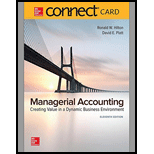
Connect 1-Semester Access Card for Managerial Accounting: Creating Value in a Dynamic Business Environment (NEW!!)
11th Edition
ISBN: 9781259727788
Author: Hilton & Platt
Publisher: MCG
expand_more
expand_more
format_list_bulleted
Textbook Question
Chapter 17, Problem 20E
Breakfasttime Cereal Company manufactures two breakfast cereals in a joint process. Cost and quantity information is as follows:

Required: Use the physical-units method to allocate the company’s joint production cost between Yummies and Crummies.
Expert Solution & Answer
Want to see the full answer?
Check out a sample textbook solution
Students have asked these similar questions
Answer financial accounting
Get correct answer general accounting question
The Ford Company developed the following
Chapter 17 Solutions
Connect 1-Semester Access Card for Managerial Accounting: Creating Value in a Dynamic Business Environment (NEW!!)
Ch. 17 - Prob. 1RQCh. 17 - Prob. 2RQCh. 17 - Should actual or budgeted service department costs...Ch. 17 - Prob. 4RQCh. 17 - Why does dual cost allocation improve the...Ch. 17 - What potential behavioral problem can result when...Ch. 17 - Should actual or budgeted service department costs...Ch. 17 - Explain the difference between two-stage...Ch. 17 - Define the following terms: joint production...Ch. 17 - Prob. 10RQ
Ch. 17 - Describe the relative-sales-value method of joint...Ch. 17 - Define the term net realizable value, and explain...Ch. 17 - Are joint cost allocations useful? If they are,...Ch. 17 - For what purpose should the managerial accountant...Ch. 17 - Prob. 15ECh. 17 - Refer to the data given in the preceding exercise....Ch. 17 - Tuscaloosa National Bank has two service...Ch. 17 - Refer to the data given in the preceding exercise....Ch. 17 - Breakfasttime Cereal Company manufactures two...Ch. 17 - Refer to the data given in the preceding exercise....Ch. 17 - Refer to the data given in Exercise 1720....Ch. 17 - Prob. 23ECh. 17 - Prob. 24PCh. 17 - Prob. 25PCh. 17 - Celestial Artistry Company is developing...Ch. 17 - Snake River Sawmill manufactures two lumber...Ch. 17 - Travelcraft Company manufactures a complete line...Ch. 17 - Biondi Industries is a manufacturer of chemicals...Ch. 17 - Berger Company manufactures products Delta, Kappa,...Ch. 17 - Prob. 31PCh. 17 - Lafayette Company manufactures two products out of...Ch. 17 - Refer to the data given in Problem 1726 for...Ch. 17 - Prob. 34PCh. 17 - Top Quality Fruit Company, based on Oahu, grows,...Ch. 17 - Prob. 36C
Knowledge Booster
Learn more about
Need a deep-dive on the concept behind this application? Look no further. Learn more about this topic, accounting and related others by exploring similar questions and additional content below.Similar questions
arrow_back_ios
SEE MORE QUESTIONS
arrow_forward_ios
Recommended textbooks for you
 Cornerstones of Cost Management (Cornerstones Ser...AccountingISBN:9781305970663Author:Don R. Hansen, Maryanne M. MowenPublisher:Cengage Learning
Cornerstones of Cost Management (Cornerstones Ser...AccountingISBN:9781305970663Author:Don R. Hansen, Maryanne M. MowenPublisher:Cengage Learning Managerial AccountingAccountingISBN:9781337912020Author:Carl Warren, Ph.d. Cma William B. TaylerPublisher:South-Western College Pub
Managerial AccountingAccountingISBN:9781337912020Author:Carl Warren, Ph.d. Cma William B. TaylerPublisher:South-Western College Pub Financial And Managerial AccountingAccountingISBN:9781337902663Author:WARREN, Carl S.Publisher:Cengage Learning,
Financial And Managerial AccountingAccountingISBN:9781337902663Author:WARREN, Carl S.Publisher:Cengage Learning,

Cornerstones of Cost Management (Cornerstones Ser...
Accounting
ISBN:9781305970663
Author:Don R. Hansen, Maryanne M. Mowen
Publisher:Cengage Learning

Managerial Accounting
Accounting
ISBN:9781337912020
Author:Carl Warren, Ph.d. Cma William B. Tayler
Publisher:South-Western College Pub

Financial And Managerial Accounting
Accounting
ISBN:9781337902663
Author:WARREN, Carl S.
Publisher:Cengage Learning,
Incremental Analysis - Sell or Process Further; Author: Melissa Shirah;https://www.youtube.com/watch?v=7D6QnBt5KPk;License: Standard Youtube License